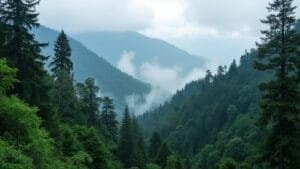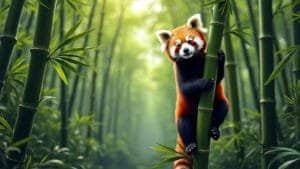The Himalayan mountains are known for their extreme elevations, frigid temperatures, and dense, rugged forests. Despite these harsh conditions, red pandas have successfully adapted to this challenging environment with a combination of unique physical features and survival behaviors. So, how do red pandas adapt to life in the Himalayan mountains? Their dense fur, heat-retaining tails, pseudo-thumbs, and agile climbing abilities are just a few of the specialized traits that allow them to thrive
This article explores the intricate ways red pandas survive in such a demanding habitat, from their behavioral adaptations—like crepuscular activity and seasonal movement—to their arboreal skills and dietary specialization. Backed by scientific studies and expert resources, this detailed look at red panda adaptations will help you understand how these elusive mammals are so finely tuned to life among the steep slopes and cool forests of the Himalayas
Physical Adaptations of Red Pandas in the Himalayas

Red pandas have evolved several physical adaptations that equip them for survival in the high-altitude, rugged, and cold environment of the Himalayan mountains. These adaptations are essential for thermoregulation, mobility, and food acquisition in a landscape where temperatures often fall below freezing, food sources are limited, and the terrain demands agility
Dense Fur and Thermoregulation in Cold Climates
One of the red panda’s most important adaptations to the Himalayan environment is its fur. The dense, woolly undercoat provides critical insulation against freezing temperatures common at elevations between 6,500 and 15,000 feet. Over this insulating layer lies a coarse, water-resistant outer fur, which acts as a barrier against snow and moisture, maintaining core warmth
A 2019 study by Glatston et al. published in Biodiversity and Conservation emphasized that red pandas are physiologically adapted to ambient temperatures as low as -4°F, largely due to their dense pelage. Unlike many mammals that seek shelter underground, red pandas remain active in snowy environments, curling up in tree hollows or branches, their thick tails wrapped tightly around their bodies like a thermal blanket
The fur covers almost their entire body—including the soles of their feet—which not only protects against heat loss but also provides traction on icy, moss-covered branches. This combination of insulation and grip is especially important when foraging or evading predators in slippery terrain
Red pandas also exhibit seasonal molting, adjusting the density and thickness of their fur as temperatures fluctuate across seasons. During monsoons and warmer months, they shed their winter coat, transitioning to a lighter, more breathable layer
Role of the Pseudo-Thumb in Feeding and Climbing
The red panda’s “pseudo-thumb” is one of the most distinctive evolutionary traits among arboreal mammals. This adaptation is not a true digit but rather a modified radial sesamoid bone located near the wrist, functioning similarly to an opposable thumb
This anatomical feature allows red pandas to grasp and manipulate objects, particularly the bamboo stalks that form 85–95% of their diet. Bamboo is not only fibrous but requires dexterity to handle efficiently. The pseudo-thumb enables the red panda to skillfully strip leaves and rotate shoots while feeding, improving their feeding efficiency and minimizing energy loss
The pseudo-thumb is also critical for arboreal navigation. Red pandas use it, along with sharp semi-retractable claws, to grasp tree trunks and branches as they move vertically through the forest. This gives them the mechanical leverage needed to maintain grip and balance in steep or precarious environments
In forests with patchy bamboo growth, the ability to climb from one canopy to another with minimal energy expenditure becomes a survival advantage, especially during bamboo flowering events when food is scarce
Tail Functions for Balance and Warmth
Perhaps the most visually striking feature of the red panda is its long, bushy tail, which averages around 18 inches in length—almost equal to the rest of its body. This tail serves two vital purposes in the Himalayan ecosystem: thermoregulation and balance
In the cold, wind-exposed heights of their mountainous habitat, red pandas often sleep curled up with their tails wrapped completely around their bodies. This not only conserves body heat but also protects sensitive facial and limb areas from frostbite. A 2016 observational study by the Red Panda Network in eastern Nepal documented how red pandas select sheltered sleeping spots and use their tails to block wind in high-exposure zones
Functionally, the tail also acts as a counterbalance. As red pandas move nimbly through trees, their tail helps stabilize their body weight, allowing them to walk across narrow branches and make swift turns without losing balance. This is especially important given their crepuscular habits, where limited light during dawn and dusk increases the risk of falls or injury
Moreover, the tail plays a minor role in communication, particularly during the breeding season when red pandas interact more frequently. Tail postures and movements may signal submission, curiosity, or territorial presence, according to behavioral notes collected by the Central Zoo Authority of India (2021)
Behavioral Strategies for Survival in the Himalayas

Surviving in the Himalayas demands more than just physical toughness—it requires behavioral flexibility. Red pandas have developed several key behavioral adaptations that help them navigate their cold, high-altitude forest habitats. These behaviors are shaped by their need to conserve energy, avoid predators, and adapt to seasonal environmental changes
As solitary, secretive mammals, red pandas fine-tune their daily activity patterns, thermoregulation habits, and even grooming rituals to match the challenging rhythm of life in the mountains. This section explores how their behavior supports their survival in some of Asia’s most demanding ecosystems
Crepuscular Activity Patterns and Energy Conservation
Red pandas are crepuscular, meaning they are most active during dawn and dusk. This specific timing provides several survival benefits. First, these twilight hours help them avoid both the midday heat and the coldest nighttime temperatures. In the cold Himalayan climate, being active during moderate temperature windows helps conserve energy that would otherwise be spent on thermoregulation
Secondly, this behavioral rhythm minimizes exposure to predators. Many of the red panda’s potential threats, such as snow leopards or martens, are either nocturnal or more active during daylight, so crepuscular activity reduces the chance of encounters. According to a 2020 field study published in Mammalian Biology, red pandas in eastern Nepal showed peak movement between 5:00 a.m. and 8:00 a.m., and again between 4:00 p.m. and 6:00 p.m., aligning with these low-risk periods
Being crepuscular also aids in foraging. Bamboo, the primary food source, is most tender and digestible during these times due to temperature-related moisture retention, which eases mechanical digestion. Given their low metabolic rate and low-calorie diet, red pandas must balance energy spent moving with energy gained from food—making this feeding schedule optimal
Red pandas spend most of their non-active hours resting, often lying across tree branches with limbs dangling or curled up in dense foliage. These positions reduce heat loss and also make them less visible to predators and humans
Seasonal Temperature Regulation Techniques
Adapting to drastic seasonal temperature variations—ranging from freezing winters to humid monsoons—is another critical aspect of red panda behavior. These animals adjust both their activity range and altitude throughout the year to stay within their thermal comfort zone
In winter, red pandas often descend to lower elevations (around 6,500–8,500 feet) where temperatures are less extreme, and snow cover is thinner, making foraging easier. Conversely, during summer, they ascend to higher elevations (above 10,000 feet) to escape rising temperatures and maintain access to fresh bamboo growth
A study by Yonzon and Hunter (1991) in the Biological Conservation Journal observed red pandas moving nearly 1,000 feet in elevation within a single week, driven by temperature changes and bamboo availability. This vertical migration is a unique behavioral adaptation seen in very few mammals and is made possible by the steep forest gradients of the Himalayas
Additionally, red pandas adjust their posture to regulate body temperature—stretching out to dissipate heat during warm days or curling tightly to retain warmth during cold spells. They also choose resting sites with specific microclimates—such as tree hollows, dense canopies, or mossy overhangs—to buffer temperature extremes
Territoriality and Grooming Behaviors
As solitary animals, red pandas establish and maintain territories using scent-marking, primarily through glands located on the soles of their feet and around their anus. These scent markings serve as invisible boundaries that help individuals avoid direct encounters with one another, reducing the risk of conflict in resource-scarce environments
Red pandas also use urine and feces to mark key feeding and resting areas. Males tend to mark more frequently during the breeding season (January through March), as indicated by elevated scent gland activity and increased tree-rubbing behavior documented by Dorji et al. (2020) in Bhutan’s Jigme Dorji National Park
Grooming is another vital behavioral adaptation. Red pandas frequently groom their fur using their tongue and forepaws. This behavior is essential not only for hygiene but also for maintaining the insulating properties of their fur. Clean, untangled fur traps more air, which improves insulation. Additionally, grooming helps reduce parasites and remove snow or debris that could compromise fur efficiency
Interestingly, red pandas exhibit a cat-like cleaning routine—licking their body in a specific sequence and using their moist paws to clean their face. This behavior helps maintain the integrity of their dense coat, especially during monsoon seasons when excess moisture could lead to fungal infections or reduced insulation
Territorial and grooming behaviors together contribute to individual survival by promoting health, reducing competition, and maintaining optimal thermal protection.
Arboreal Adaptations and Environmental Interaction

Red pandas are quintessential arboreal mammals, spending the majority of their lives navigating tree canopies in the steep forests of the Himalayas. This lifestyle offers protection from predators, access to food, and thermoregulatory advantages. Their bodies are biomechanically optimized for life among branches, with flexible joints, semi-retractable claws, and sharp spatial awareness
In addition to climbing prowess, red pandas interact with their environment through behaviors that enhance their safety and efficiency in foraging and sheltering. This section breaks down the intricate physical and behavioral adaptations that allow red pandas to thrive above the forest floor
Climbing Skills and Flexible Ankles
One of the red panda’s most notable climbing adaptations is its rotating ankle joints. Unlike most mammals, red pandas can rotate their ankles outward, allowing them to descend trees headfirst—a skill that few arboreal animals possess. This agility is not only useful for escaping predators but also for maneuvering quickly while foraging across vertical and diagonal tree surfaces
The importance of this adaptation was highlighted in a biomechanical analysis by Wang et al. (2018) published in Scientific Reports, which noted that red pandas share this trait with only a few other mammals, such as margays and certain primates. The rotation is facilitated by the mobility of the tibia and fibula in relation to the tarsal bones, giving them a high degree of ankle flexibility
Their climbing skills are further enhanced by strong, curved claws that are semi-retractable, providing a secure grip on bark. These claws also help dig into bamboo stalks and tree branches, stabilizing them while they feed or rest
Red pandas are often seen climbing with a lateral-sequence gait, meaning their limbs move on one side of the body followed by the other—a movement pattern that enhances balance and energy efficiency when navigating complex arboreal terrain. Combined with muscular limbs and a lightweight body, this makes them exceptionally mobile in forest canopies
For additional insights into the mechanics of red panda climbing and their skeletal traits, the Redwood Zoo adaptation article discusses how these traits evolved to match their mountainous environment
Use of Forest Structure for Shelter and Foraging
Red pandas are highly selective about the parts of the forest they use. They favor mature temperate forests with dense canopy cover (over 70%), allowing them to move through trees with minimal exposure to predators. These areas also provide thermal buffering, shelter from precipitation, and increased availability of food sources like bamboo, berries, and tree leaves
Their sheltering preferences are precise. Red pandas often choose roosting sites in tree hollows, large branches covered in moss, or densely foliated areas that are shaded and slightly elevated. These roosts help regulate body temperature and protect against inclement weather
Foraging is closely tied to these same structural preferences. Red pandas forage primarily in understory layers of forests, where bamboo species such as Fargesia and Yushania thrive. They often move along natural corridors formed by interlocking branches or dense bamboo clusters, which also serve as visual cover from raptors and ground predators
Their limited energy budget means red pandas must balance movement with energy intake. As such, they exhibit foraging site fidelity—returning to known food patches rather than exploring new territory, a behavior documented in Nepal’s Kanchenjunga region during a long-term tracking study by WWF Nepal in 2020
Predator Avoidance and Canopy Navigation
Red pandas are prey to a number of forest predators, including snow leopards, martens, and birds of prey. Their primary defense mechanism is avoidance, and their arboreal agility plays a key role. By remaining in the canopy, red pandas limit the chances of ground-based attacks. If threatened, they will climb higher or freeze in place, blending into the reddish-brown and moss-colored tree trunks
Camouflage is a natural extension of their reddish fur, which mimics the color of mosses and lichens commonly found in their forest environment. Their positioning in the tree canopy—often on horizontal branches 10 to 30 feet above ground—maximizes concealment from predators scanning from above or below
Additionally, red pandas use scent-marking to warn potential rivals and deter predators. By leaving their unique scent signatures around key travel routes and resting sites, they minimize surprise encounters. These arboreal and environmental adaptations form an essential component of the red panda’s survival toolkit, allowing them to navigate, feed, hide, and rest effectively in a landscape filled with natural threats












